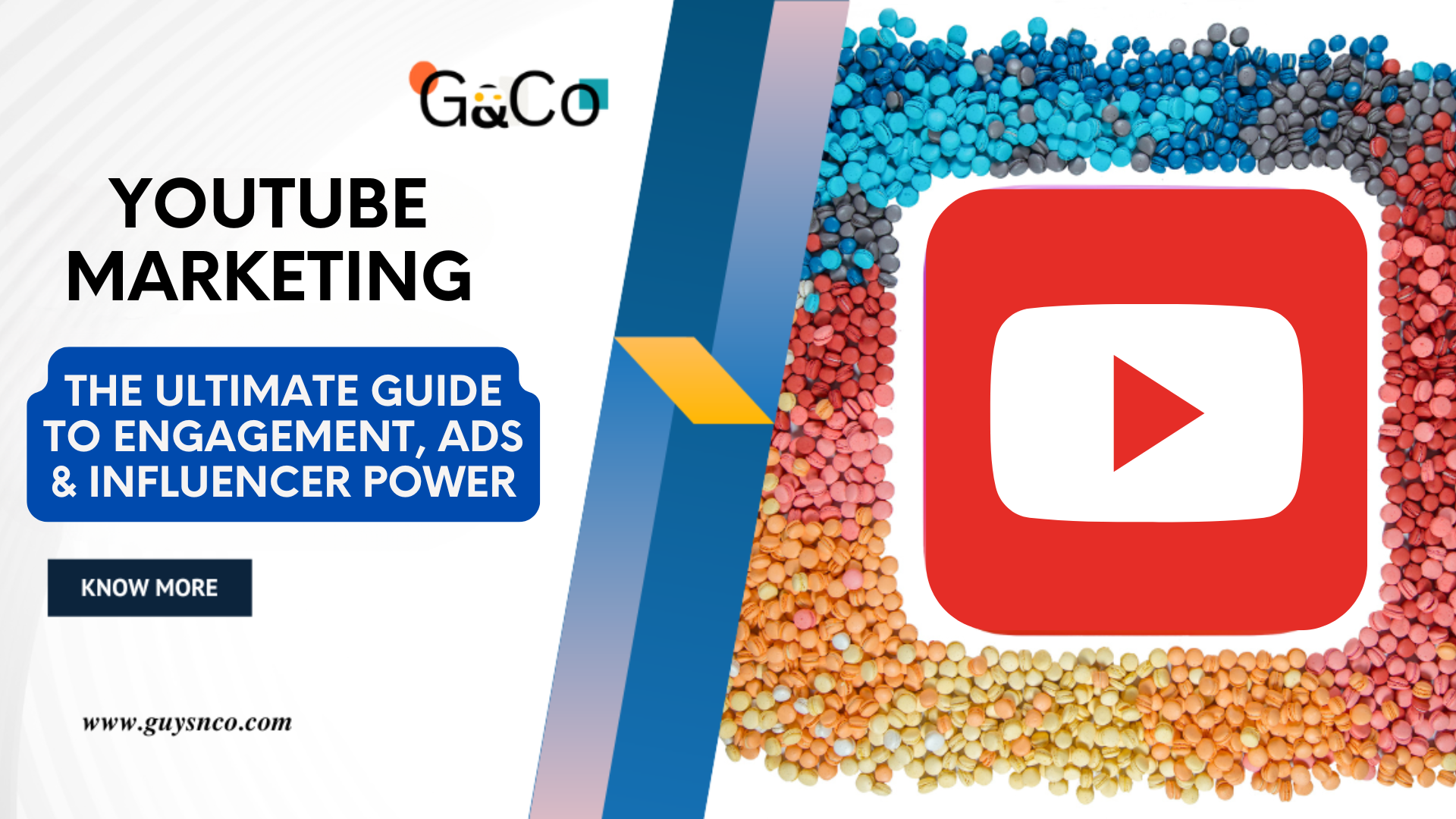YouTube Marketing Starts: The Ultimate Guide to Engagement, Ads & Influencer Power
- 68 Views
- Phani Kelam
- April 4, 2025
- Blog
Why YouTube Marketing Matters
YouTube has evolved into more than just a video platform it’s now one of the most powerful digital marketing tools available.
With over 2.7 billion monthly users, businesses that leverage YouTube can reach a massive, global audience. Whether you’re launching a brand, showcasing products, or growing a personal brand, YouTube marketing provides unmatched visibility.
In a world where visual content is king, video helps humanize brands and creates meaningful engagement. Likes, shares, and comments turn passive viewers into active participants, amplifying content reach.
As consumer behavior continues shifting toward video consumption, ignoring YouTube in your marketing mix is no longer an option.
Understanding the YouTube Ecosystem
- YouTube is a vast, algorithm-driven ecosystem where video content reigns supreme. It’s a platform where creators, businesses, and audiences converge.
- To succeed here, marketers must understand how the YouTube algorithm works, prioritizing watch time, viewer retention, and engagement.
- Every element titles, thumbnails, tags, descriptions feeds into discoverability. It’s also a search engine in its own right, second only to Google, which means optimizing your videos for search visibility is critical.
- By aligning content with audience interests and using strategic keywords, brands can significantly increase their reach and influence. Navigating this dynamic space requires both creative content and technical finesse.
Setting Your YouTube Marketing Goals
- Before diving into content creation, it’s essential to define what you want to achieve with YouTube marketing.
- Are you aiming for brand awareness, lead generation, product sales, or community engagement? Each goal demands a different strategy and measurement metric.
- For instance, increasing brand awareness may focus on video views and impressions, while lead generation might track clicks and conversions.
- Having clear objectives allows for better planning, content direction, and performance analysis. It also helps in allocating budgets, whether it’s for video production, paid ads, or influencer collaborations.
- A goal-focused approach ensures your YouTube efforts contribute meaningfully to your overall marketing strategy.
Creating High-Impact Video Content
- Quality content is the backbone of YouTube marketing success. Videos must not only be visually appealing but also provide value whether it’s educational, entertaining, or inspirational.
- Storytelling plays a key role in keeping audiences hooked and boosting watch time, a crucial factor in the algorithm.
- The first 10 seconds are especially critical, as they determine whether viewers will stay or bounce. Investing in good lighting, clear audio, and professional editing can dramatically elevate your content.
- Additionally, incorporating calls-to-action (CTAs) encourages viewers to like, comment, subscribe, or visit your website. Every video should serve a purpose and align with your brand’s message.
The Power of Influencer Collaborations
- Influencers hold significant sway on YouTube, making them valuable partners in marketing campaigns. Collaborating with the right influencers allows brands to tap into pre-established communities and foster authentic engagement.
- It’s essential to choose influencers whose values align with your brand and whose audiences mirror your target demographics.
- Sponsored content, product reviews, unboxings, or challenges can seamlessly promote your offerings without seeming overly promotional.
- These collaborations often result in higher trust and conversion rates than traditional ads. Moreover, influencer marketing adds a human touch to your brand, enhancing relatability and reach.
Running Effective YouTube Ads
- YouTube offers several ad formats, including skippable in-stream ads, non-skippable ads, bumper ads, and display ads.
- Each serves a different purpose and fits various stages of the customer journey. Skippable ads are ideal for awareness, while non-skippable ones ensure your message is fully seen.
- Crafting compelling ad content requires a strong hook in the first few seconds to retain attention. Targeting options based on interests, keywords, demographics, or retargeting—allow precision in reaching the right audience.
- Performance tracking is essential, measuring impressions, view-through rates, and conversions. With the right strategy, YouTube ads can yield impressive ROI.
Boosting Engagement with Likes, Comments, and Shares
- Engagement metrics like likes, comments, and shares are critical to YouTube success. They signal to the algorithm that your content is valuable, thereby increasing its visibility.
- Encouraging viewers to interact isn’t just about asking it’s about creating content worth engaging with.
- Ask questions in your videos to prompt comments, include subtle reminders to like or share, and create community polls or challenges.
- Responding to comments also boosts interaction and builds a loyal community. The more people engage, the more your video spreads organically across the platform, enhancing both reach and credibility.
Optimizing Video Titles, Descriptions, and Tags
- Search Engine Optimization (SEO) on YouTube hinges on well-optimized titles, descriptions, and tags. The title should be catchy and include your focus keyword early on to improve search visibility.
- Descriptions offer a chance to provide context, include links, and utilize additional keywords. Tags help YouTube understand your video’s topic and associate it with related content.
- It’s also helpful to include relevant hashtags and timestamps for longer videos. These metadata elements contribute to the discoverability of your content and improve user experience, increasing the likelihood of engagement and retention.
Thumbnail Design and Visual Strategy
- A video’s thumbnail is often the first impression viewers get, and it heavily influences click-through rates.
- Thumbnails should be custom-designed, eye-catching, and reflective of the video content. Use contrasting colors, readable fonts, and expressive faces or emotions to grab attention.
- Avoid misleading visuals, as they can harm credibility and lead to high bounce rates. Consistent visual branding across thumbnails through colors, logos, and layout reinforces brand identity and builds viewer recognition.
- A/B testing different thumbnails can also help determine which styles resonate most with your audience.
Leveraging YouTube Shorts for Viral Reach
- YouTube Shorts, the platform’s answer to short-form content, offers new opportunities for viral exposure. These vertical videos, under 60 seconds, are prioritized by the algorithm for mobile users.
- Shorts are ideal for teasers, product highlights, tips, and engaging challenges. They’re a great way to reach new audiences quickly and drive traffic to longer-form content.
- While short in duration, they still need to be punchy, valuable, and visually engaging. Including CTAs or encouraging viewers to explore your channel can help convert short attention spans into long-term subscribers.
Tracking and Measuring Performance Metrics
- Success on YouTube depends on consistent tracking and analysis. YouTube Analytics provides insights into views, watch time, retention, click-through rates, and more.
- Understanding what works and what doesn’t enables data-driven decision-making. Metrics like average view duration and audience retention help optimize content structure, while engagement stats inform content relevance.
- Comparing performance across videos or campaigns can highlight trends and content gaps. Regular analysis ensures you adapt to audience preferences and continually refine your YouTube marketing strategy for better results.
Cross-Promotion and Sharing Strategies
- To maximize visibility, share your videos across other platforms such as Facebook, LinkedIn, Twitter, and Instagram.
- Embedding videos in blog posts or email newsletters can also increase views and engagement. Collaborate with partners or affiliates to cross-promote each other’s content.
- Creating playlists or linking to related videos encourages binge-watching and increases session time. Consider using QR codes or links in offline materials to drive traffic to your YouTube channel.
- Cross-platform integration ensures your content reaches broader audiences and reinforces your brand message across multiple touchpoints.
Building a Loyal YouTube Community
- Beyond views and subscribers, building a strong community is key to long-term success. Engage regularly with your audience through comments, community posts, and livestreams.
- Feature user-generated content or shout-outs to loyal subscribers. Transparency, consistency, and authenticity go a long way in cultivating trust and loyalty.
- The more connected your audience feels, the more likely they are to return, interact, and advocate for your brand.
- Community-building transforms viewers into brand ambassadors who amplify your reach organically.
Avoiding Common YouTube Marketing Mistakes
- Many marketers fail on YouTube due to poor planning or unrealistic expectations. Common pitfalls include inconsistent posting, lack of SEO, ignoring analytics, or over-reliance on paid ads.
- Not engaging with the audience or producing low-quality content can hurt credibility. Avoid clickbait titles that mislead viewers, as this results in high bounce rates.
- Understanding the platform’s guidelines and copyright policies is also crucial to avoid demonetization or removal.
- By learning from others’ mistakes, you can refine your approach and maintain sustainable growth.
Future Trends in YouTube Marketing
- YouTube marketing is constantly evolving. Trends like AI-generated content, interactive videos, shoppable links, and deeper personalization are shaping the future.
- Expect increased emphasis on YouTube Shorts and integration with e-commerce platforms. Voice search optimization and localization will also play larger roles.
- Staying ahead requires continuous learning, experimenting with new formats, and adapting to emerging technologies.
- The most successful marketers will be those who blend creativity with data and stay attuned to audience behavior shifts.
Conclusion: Launching Your YouTube Marketing Journey
Starting with YouTube marketing is both exciting and rewarding when approached strategically. By understanding the platform, setting goals, creating quality content, and engaging with your audience, you lay the foundation for long-term success.
Leveraging tools like ads, influencers, and analytics further enhances your results. Stay consistent, authentic, and responsive to trends, and your YouTube presence will grow exponentially.
Whether you’re a solo creator or a global brand, YouTube holds immense potential to elevate your marketing efforts.
FAQs about YouTube Marketing
1. How do I start marketing on YouTube if I’m new to the platform?
Start by creating a branded channel with a clear niche. Develop a content strategy based on your target audience’s interests, and post consistently. Use SEO techniques to optimize video titles, descriptions, and tags.
2. What types of videos perform best on YouTube?
How-to videos, product reviews, tutorials, vlogs, and list-style content tend to perform well. However, success depends on your niche and how well the content connects with your audience.
3. How much should I budget for YouTube marketing?
Budgets can vary widely depending on goals. For small creators, even $100–$500/month can yield results through content production and ads. Larger brands may invest thousands in influencer partnerships and high-end video production.
4. How do I measure success on YouTube?
Key metrics include watch time, click-through rate (CTR), audience retention, likes, comments, shares, and subscriber growth. Use YouTube Analytics to monitor trends and performance.
5. Can I make money through YouTube marketing?
Yes. Brands can earn through affiliate marketing, brand sponsorships, and AdSense revenue. For businesses, the return comes through increased leads, sales, and brand exposure.




















